Critical Analysis: Lewin's and Kotter's Change Management Models
VerifiedAdded on 2023/06/05
|8
|2256
|293
Essay
AI Summary
This essay critically evaluates and compares Kurt Lewin's three-stage change model and John Kotter's eight-step change management model, exploring their similarities, differences, strengths, and weaknesses in the context of organizational change. The essay begins by highlighting the core philosophies of both models, emphasizing Lewin's simplicity and Kotter's detailed approach. It then delves into the stages of Lewin's model (unfreezing, changing, refreezing) and Kotter's eight steps (establishing a sense of urgency, creating a guiding coalition, developing a vision, communicating the vision, empowering broad-based action, generating short-term wins, consolidating gains, and anchoring new approaches), identifying their respective contributions to effective change management. The analysis reveals that while both models share the goal of transitioning organizations to new paradigms, Kotter's model offers a more structured and practical framework for implementation. The essay also discusses criticisms and limitations of both models, such as the potential for resistance and the neglect of human factors in Lewin's model, and the top-down nature and focus on urgency in Kotter's model. Ultimately, the essay concludes that while no single change management formula fits every organization, Kotter's model may be more suitable for contemporary organizations because it is more detailed and enables substantial changes, while Lewin's model provides a more planned approach.
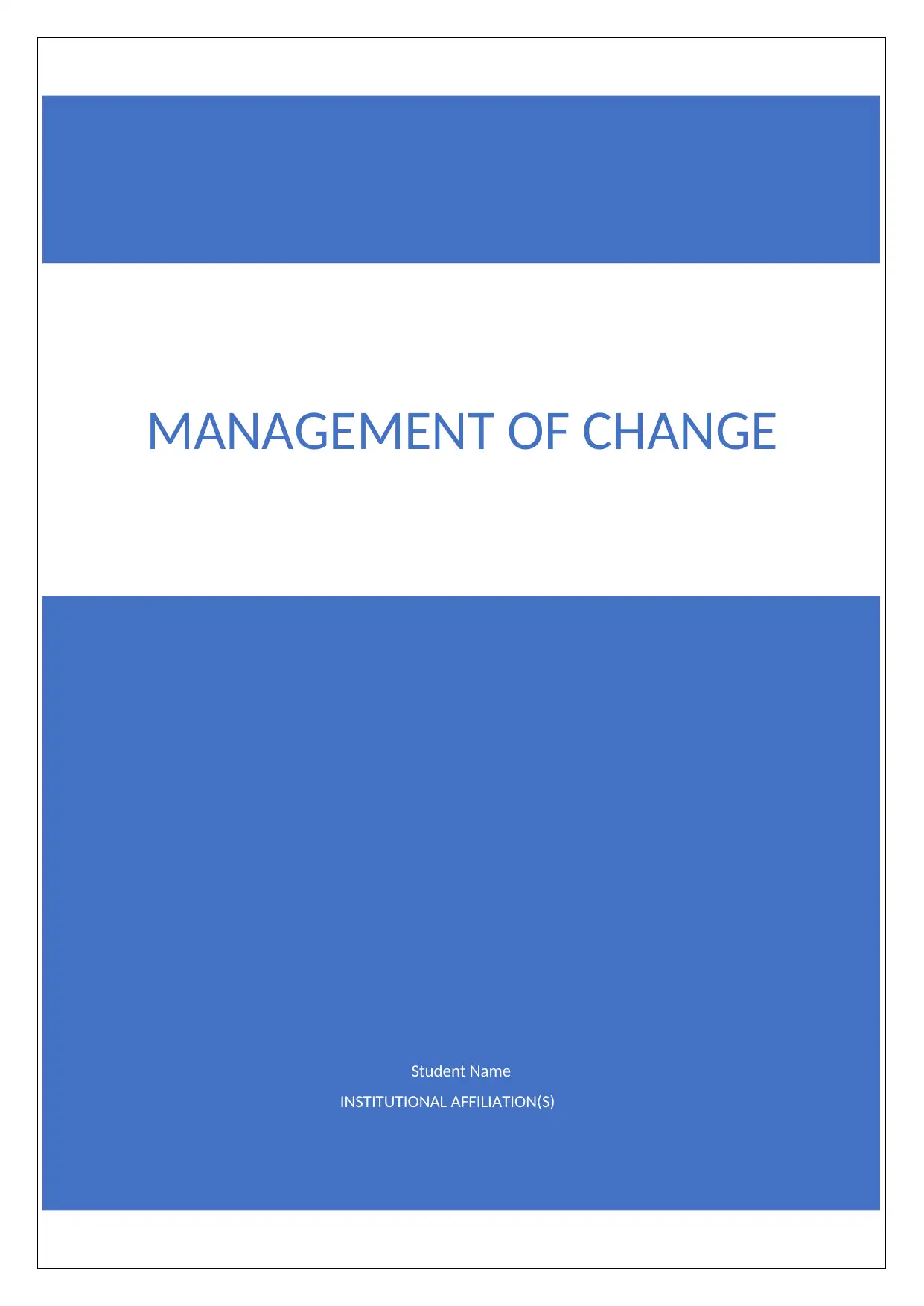
Student Name
INSTITUTIONAL AFFILIATION(S)
MANAGEMENT OF CHANGE
INSTITUTIONAL AFFILIATION(S)
MANAGEMENT OF CHANGE
Paraphrase This Document
Need a fresh take? Get an instant paraphrase of this document with our AI Paraphraser
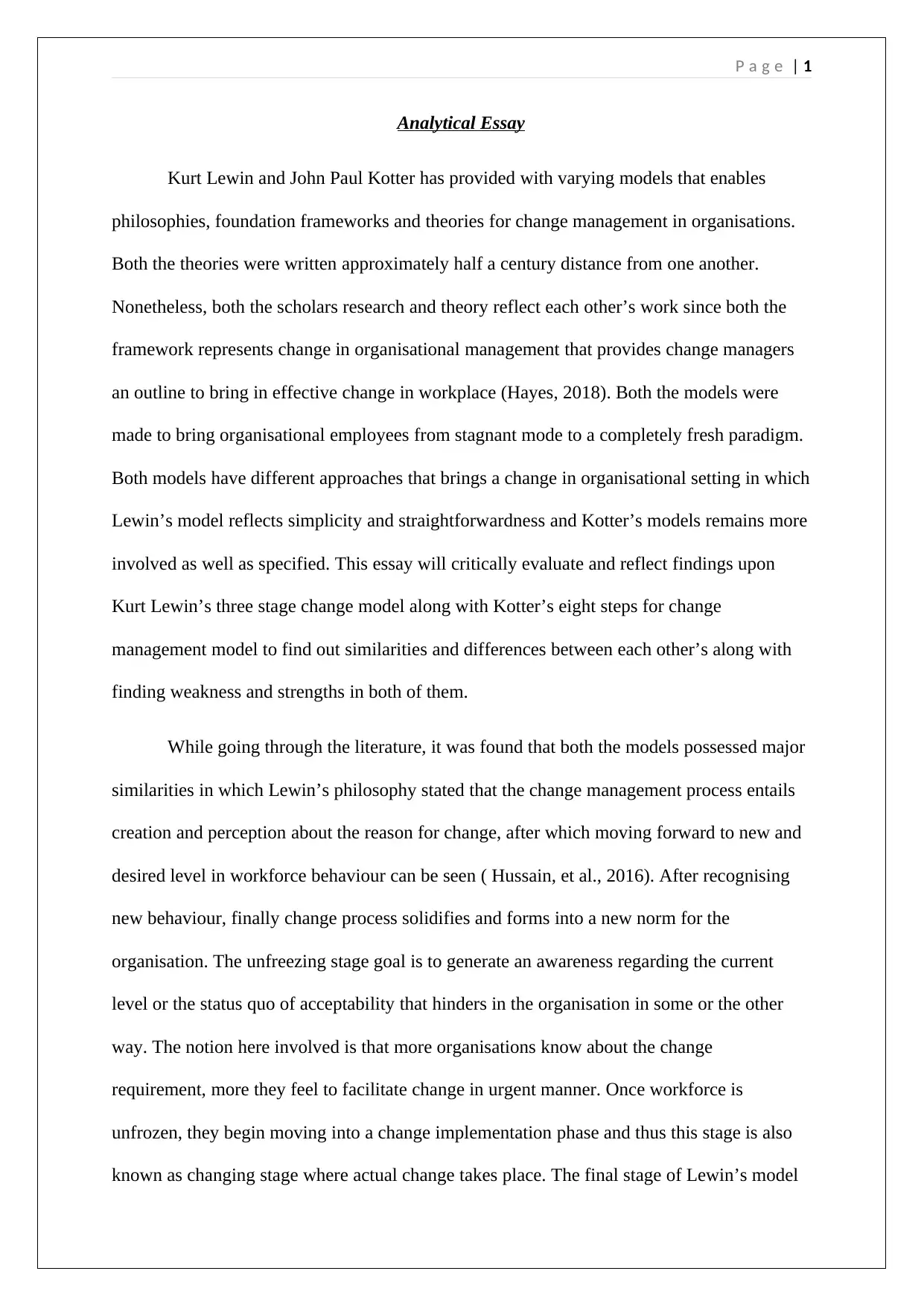
P a g e | 1
Analytical Essay
Kurt Lewin and John Paul Kotter has provided with varying models that enables
philosophies, foundation frameworks and theories for change management in organisations.
Both the theories were written approximately half a century distance from one another.
Nonetheless, both the scholars research and theory reflect each other’s work since both the
framework represents change in organisational management that provides change managers
an outline to bring in effective change in workplace (Hayes, 2018). Both the models were
made to bring organisational employees from stagnant mode to a completely fresh paradigm.
Both models have different approaches that brings a change in organisational setting in which
Lewin’s model reflects simplicity and straightforwardness and Kotter’s models remains more
involved as well as specified. This essay will critically evaluate and reflect findings upon
Kurt Lewin’s three stage change model along with Kotter’s eight steps for change
management model to find out similarities and differences between each other’s along with
finding weakness and strengths in both of them.
While going through the literature, it was found that both the models possessed major
similarities in which Lewin’s philosophy stated that the change management process entails
creation and perception about the reason for change, after which moving forward to new and
desired level in workforce behaviour can be seen ( Hussain, et al., 2016). After recognising
new behaviour, finally change process solidifies and forms into a new norm for the
organisation. The unfreezing stage goal is to generate an awareness regarding the current
level or the status quo of acceptability that hinders in the organisation in some or the other
way. The notion here involved is that more organisations know about the change
requirement, more they feel to facilitate change in urgent manner. Once workforce is
unfrozen, they begin moving into a change implementation phase and thus this stage is also
known as changing stage where actual change takes place. The final stage of Lewin’s model
Analytical Essay
Kurt Lewin and John Paul Kotter has provided with varying models that enables
philosophies, foundation frameworks and theories for change management in organisations.
Both the theories were written approximately half a century distance from one another.
Nonetheless, both the scholars research and theory reflect each other’s work since both the
framework represents change in organisational management that provides change managers
an outline to bring in effective change in workplace (Hayes, 2018). Both the models were
made to bring organisational employees from stagnant mode to a completely fresh paradigm.
Both models have different approaches that brings a change in organisational setting in which
Lewin’s model reflects simplicity and straightforwardness and Kotter’s models remains more
involved as well as specified. This essay will critically evaluate and reflect findings upon
Kurt Lewin’s three stage change model along with Kotter’s eight steps for change
management model to find out similarities and differences between each other’s along with
finding weakness and strengths in both of them.
While going through the literature, it was found that both the models possessed major
similarities in which Lewin’s philosophy stated that the change management process entails
creation and perception about the reason for change, after which moving forward to new and
desired level in workforce behaviour can be seen ( Hussain, et al., 2016). After recognising
new behaviour, finally change process solidifies and forms into a new norm for the
organisation. The unfreezing stage goal is to generate an awareness regarding the current
level or the status quo of acceptability that hinders in the organisation in some or the other
way. The notion here involved is that more organisations know about the change
requirement, more they feel to facilitate change in urgent manner. Once workforce is
unfrozen, they begin moving into a change implementation phase and thus this stage is also
known as changing stage where actual change takes place. The final stage of Lewin’s model
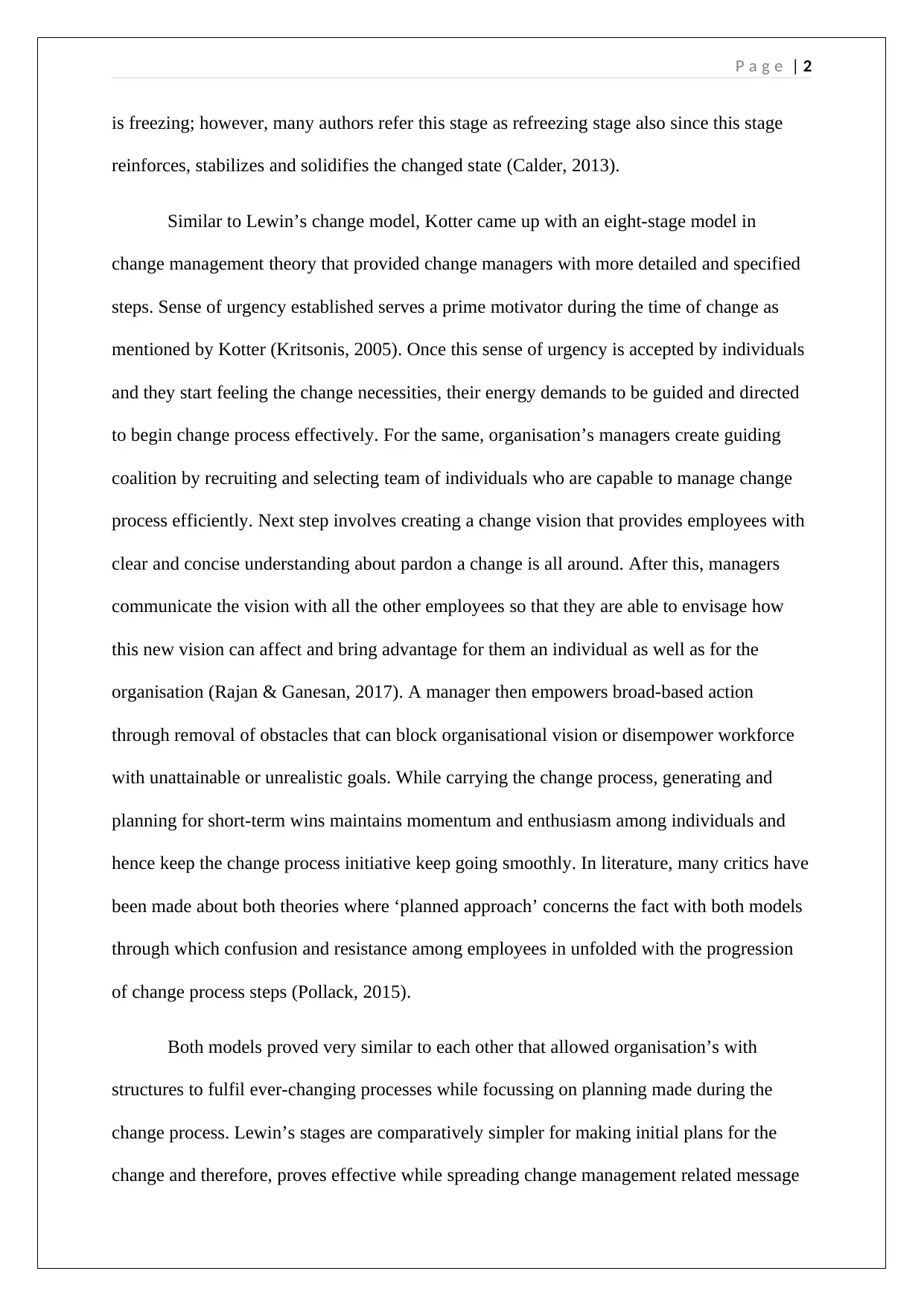
P a g e | 2
is freezing; however, many authors refer this stage as refreezing stage also since this stage
reinforces, stabilizes and solidifies the changed state (Calder, 2013).
Similar to Lewin’s change model, Kotter came up with an eight-stage model in
change management theory that provided change managers with more detailed and specified
steps. Sense of urgency established serves a prime motivator during the time of change as
mentioned by Kotter (Kritsonis, 2005). Once this sense of urgency is accepted by individuals
and they start feeling the change necessities, their energy demands to be guided and directed
to begin change process effectively. For the same, organisation’s managers create guiding
coalition by recruiting and selecting team of individuals who are capable to manage change
process efficiently. Next step involves creating a change vision that provides employees with
clear and concise understanding about pardon a change is all around. After this, managers
communicate the vision with all the other employees so that they are able to envisage how
this new vision can affect and bring advantage for them an individual as well as for the
organisation (Rajan & Ganesan, 2017). A manager then empowers broad-based action
through removal of obstacles that can block organisational vision or disempower workforce
with unattainable or unrealistic goals. While carrying the change process, generating and
planning for short-term wins maintains momentum and enthusiasm among individuals and
hence keep the change process initiative keep going smoothly. In literature, many critics have
been made about both theories where ‘planned approach’ concerns the fact with both models
through which confusion and resistance among employees in unfolded with the progression
of change process steps (Pollack, 2015).
Both models proved very similar to each other that allowed organisation’s with
structures to fulfil ever-changing processes while focussing on planning made during the
change process. Lewin’s stages are comparatively simpler for making initial plans for the
change and therefore, proves effective while spreading change management related message
is freezing; however, many authors refer this stage as refreezing stage also since this stage
reinforces, stabilizes and solidifies the changed state (Calder, 2013).
Similar to Lewin’s change model, Kotter came up with an eight-stage model in
change management theory that provided change managers with more detailed and specified
steps. Sense of urgency established serves a prime motivator during the time of change as
mentioned by Kotter (Kritsonis, 2005). Once this sense of urgency is accepted by individuals
and they start feeling the change necessities, their energy demands to be guided and directed
to begin change process effectively. For the same, organisation’s managers create guiding
coalition by recruiting and selecting team of individuals who are capable to manage change
process efficiently. Next step involves creating a change vision that provides employees with
clear and concise understanding about pardon a change is all around. After this, managers
communicate the vision with all the other employees so that they are able to envisage how
this new vision can affect and bring advantage for them an individual as well as for the
organisation (Rajan & Ganesan, 2017). A manager then empowers broad-based action
through removal of obstacles that can block organisational vision or disempower workforce
with unattainable or unrealistic goals. While carrying the change process, generating and
planning for short-term wins maintains momentum and enthusiasm among individuals and
hence keep the change process initiative keep going smoothly. In literature, many critics have
been made about both theories where ‘planned approach’ concerns the fact with both models
through which confusion and resistance among employees in unfolded with the progression
of change process steps (Pollack, 2015).
Both models proved very similar to each other that allowed organisation’s with
structures to fulfil ever-changing processes while focussing on planning made during the
change process. Lewin’s stages are comparatively simpler for making initial plans for the
change and therefore, proves effective while spreading change management related message
⊘ This is a preview!⊘
Do you want full access?
Subscribe today to unlock all pages.

Trusted by 1+ million students worldwide
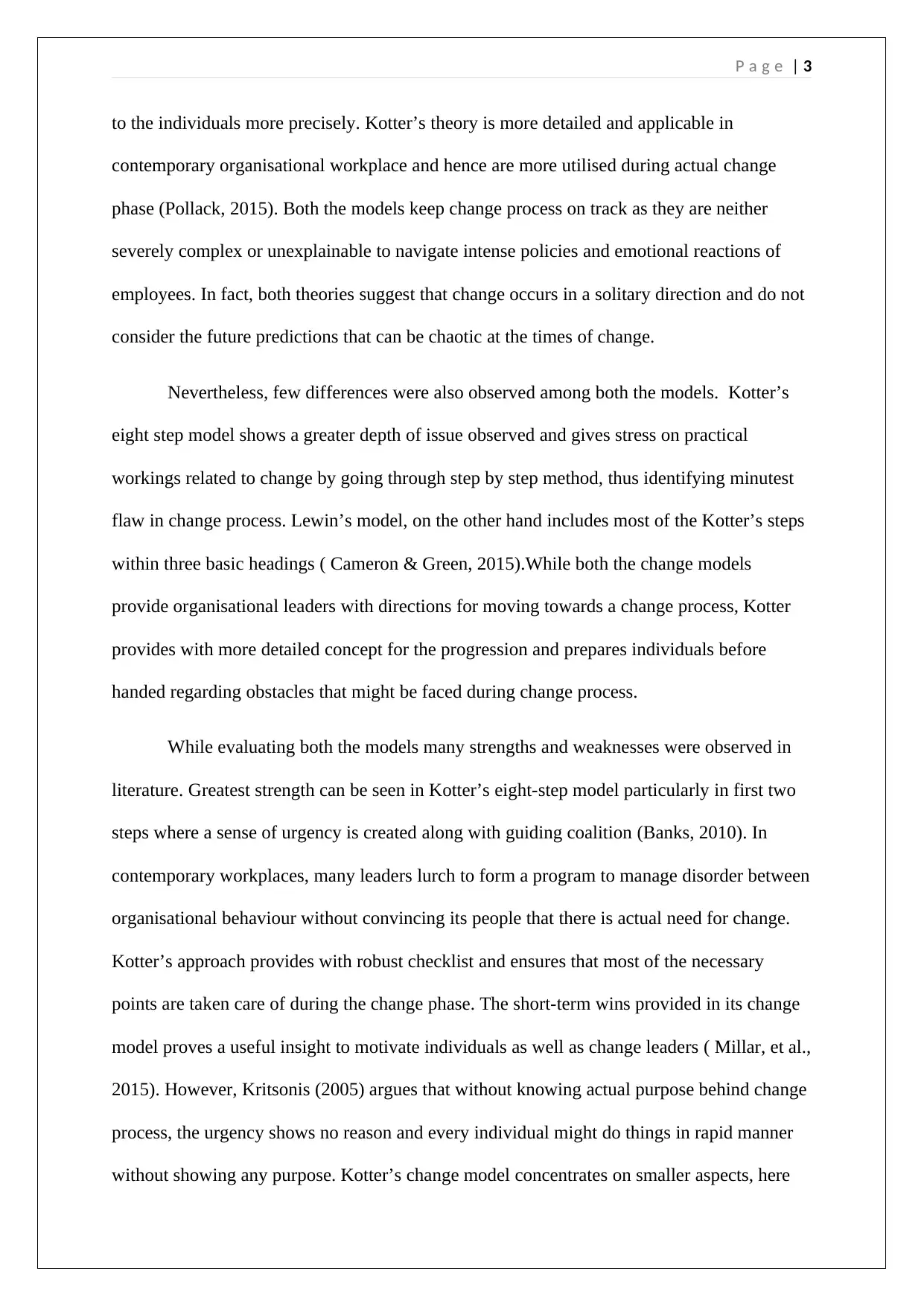
P a g e | 3
to the individuals more precisely. Kotter’s theory is more detailed and applicable in
contemporary organisational workplace and hence are more utilised during actual change
phase (Pollack, 2015). Both the models keep change process on track as they are neither
severely complex or unexplainable to navigate intense policies and emotional reactions of
employees. In fact, both theories suggest that change occurs in a solitary direction and do not
consider the future predictions that can be chaotic at the times of change.
Nevertheless, few differences were also observed among both the models. Kotter’s
eight step model shows a greater depth of issue observed and gives stress on practical
workings related to change by going through step by step method, thus identifying minutest
flaw in change process. Lewin’s model, on the other hand includes most of the Kotter’s steps
within three basic headings ( Cameron & Green, 2015).While both the change models
provide organisational leaders with directions for moving towards a change process, Kotter
provides with more detailed concept for the progression and prepares individuals before
handed regarding obstacles that might be faced during change process.
While evaluating both the models many strengths and weaknesses were observed in
literature. Greatest strength can be seen in Kotter’s eight-step model particularly in first two
steps where a sense of urgency is created along with guiding coalition (Banks, 2010). In
contemporary workplaces, many leaders lurch to form a program to manage disorder between
organisational behaviour without convincing its people that there is actual need for change.
Kotter’s approach provides with robust checklist and ensures that most of the necessary
points are taken care of during the change phase. The short-term wins provided in its change
model proves a useful insight to motivate individuals as well as change leaders ( Millar, et al.,
2015). However, Kritsonis (2005) argues that without knowing actual purpose behind change
process, the urgency shows no reason and every individual might do things in rapid manner
without showing any purpose. Kotter’s change model concentrates on smaller aspects, here
to the individuals more precisely. Kotter’s theory is more detailed and applicable in
contemporary organisational workplace and hence are more utilised during actual change
phase (Pollack, 2015). Both the models keep change process on track as they are neither
severely complex or unexplainable to navigate intense policies and emotional reactions of
employees. In fact, both theories suggest that change occurs in a solitary direction and do not
consider the future predictions that can be chaotic at the times of change.
Nevertheless, few differences were also observed among both the models. Kotter’s
eight step model shows a greater depth of issue observed and gives stress on practical
workings related to change by going through step by step method, thus identifying minutest
flaw in change process. Lewin’s model, on the other hand includes most of the Kotter’s steps
within three basic headings ( Cameron & Green, 2015).While both the change models
provide organisational leaders with directions for moving towards a change process, Kotter
provides with more detailed concept for the progression and prepares individuals before
handed regarding obstacles that might be faced during change process.
While evaluating both the models many strengths and weaknesses were observed in
literature. Greatest strength can be seen in Kotter’s eight-step model particularly in first two
steps where a sense of urgency is created along with guiding coalition (Banks, 2010). In
contemporary workplaces, many leaders lurch to form a program to manage disorder between
organisational behaviour without convincing its people that there is actual need for change.
Kotter’s approach provides with robust checklist and ensures that most of the necessary
points are taken care of during the change phase. The short-term wins provided in its change
model proves a useful insight to motivate individuals as well as change leaders ( Millar, et al.,
2015). However, Kritsonis (2005) argues that without knowing actual purpose behind change
process, the urgency shows no reason and every individual might do things in rapid manner
without showing any purpose. Kotter’s change model concentrates on smaller aspects, here
Paraphrase This Document
Need a fresh take? Get an instant paraphrase of this document with our AI Paraphraser
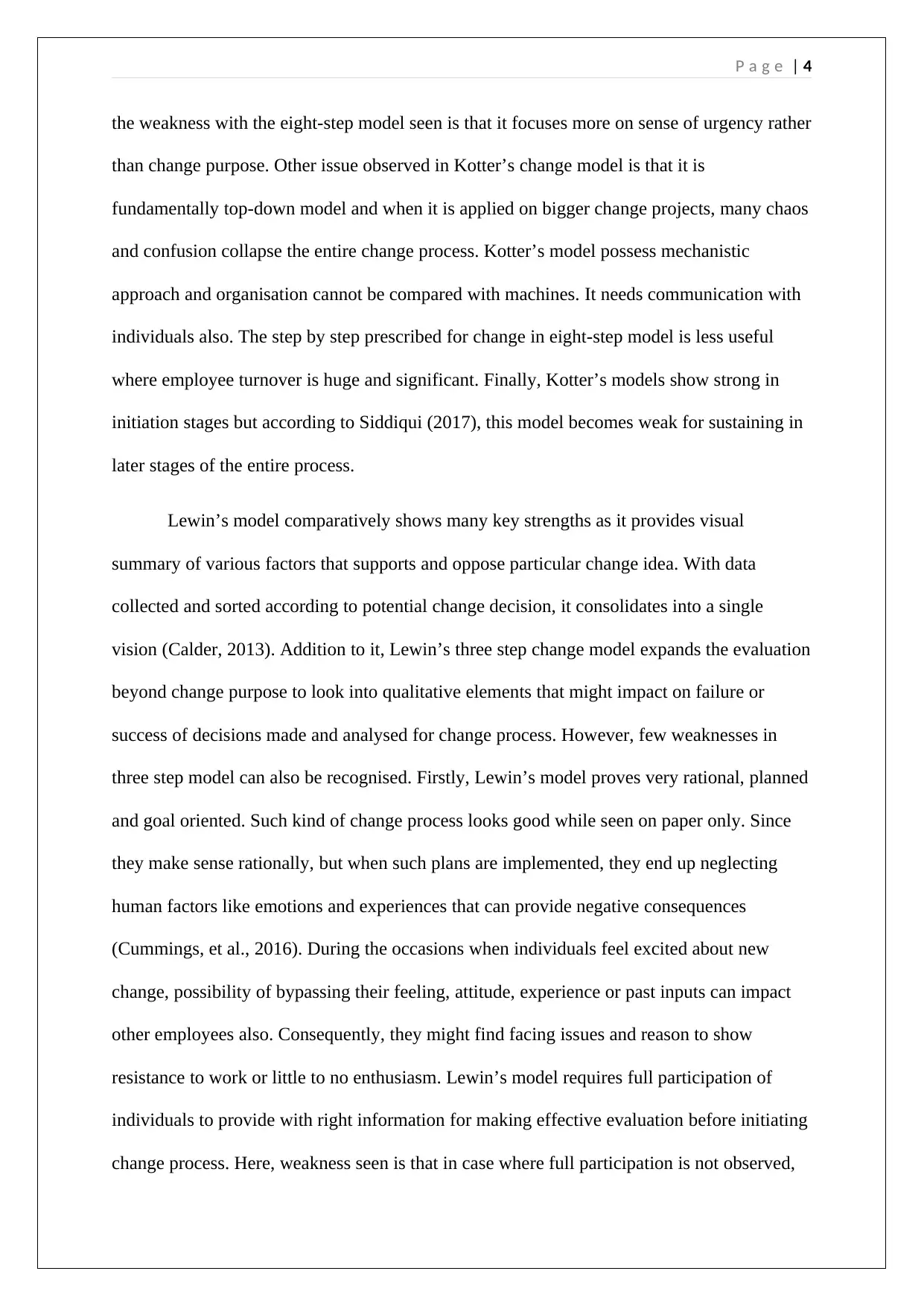
P a g e | 4
the weakness with the eight-step model seen is that it focuses more on sense of urgency rather
than change purpose. Other issue observed in Kotter’s change model is that it is
fundamentally top-down model and when it is applied on bigger change projects, many chaos
and confusion collapse the entire change process. Kotter’s model possess mechanistic
approach and organisation cannot be compared with machines. It needs communication with
individuals also. The step by step prescribed for change in eight-step model is less useful
where employee turnover is huge and significant. Finally, Kotter’s models show strong in
initiation stages but according to Siddiqui (2017), this model becomes weak for sustaining in
later stages of the entire process.
Lewin’s model comparatively shows many key strengths as it provides visual
summary of various factors that supports and oppose particular change idea. With data
collected and sorted according to potential change decision, it consolidates into a single
vision (Calder, 2013). Addition to it, Lewin’s three step change model expands the evaluation
beyond change purpose to look into qualitative elements that might impact on failure or
success of decisions made and analysed for change process. However, few weaknesses in
three step model can also be recognised. Firstly, Lewin’s model proves very rational, planned
and goal oriented. Such kind of change process looks good while seen on paper only. Since
they make sense rationally, but when such plans are implemented, they end up neglecting
human factors like emotions and experiences that can provide negative consequences
(Cummings, et al., 2016). During the occasions when individuals feel excited about new
change, possibility of bypassing their feeling, attitude, experience or past inputs can impact
other employees also. Consequently, they might find facing issues and reason to show
resistance to work or little to no enthusiasm. Lewin’s model requires full participation of
individuals to provide with right information for making effective evaluation before initiating
change process. Here, weakness seen is that in case where full participation is not observed,
the weakness with the eight-step model seen is that it focuses more on sense of urgency rather
than change purpose. Other issue observed in Kotter’s change model is that it is
fundamentally top-down model and when it is applied on bigger change projects, many chaos
and confusion collapse the entire change process. Kotter’s model possess mechanistic
approach and organisation cannot be compared with machines. It needs communication with
individuals also. The step by step prescribed for change in eight-step model is less useful
where employee turnover is huge and significant. Finally, Kotter’s models show strong in
initiation stages but according to Siddiqui (2017), this model becomes weak for sustaining in
later stages of the entire process.
Lewin’s model comparatively shows many key strengths as it provides visual
summary of various factors that supports and oppose particular change idea. With data
collected and sorted according to potential change decision, it consolidates into a single
vision (Calder, 2013). Addition to it, Lewin’s three step change model expands the evaluation
beyond change purpose to look into qualitative elements that might impact on failure or
success of decisions made and analysed for change process. However, few weaknesses in
three step model can also be recognised. Firstly, Lewin’s model proves very rational, planned
and goal oriented. Such kind of change process looks good while seen on paper only. Since
they make sense rationally, but when such plans are implemented, they end up neglecting
human factors like emotions and experiences that can provide negative consequences
(Cummings, et al., 2016). During the occasions when individuals feel excited about new
change, possibility of bypassing their feeling, attitude, experience or past inputs can impact
other employees also. Consequently, they might find facing issues and reason to show
resistance to work or little to no enthusiasm. Lewin’s model requires full participation of
individuals to provide with right information for making effective evaluation before initiating
change process. Here, weakness seen is that in case where full participation is not observed,
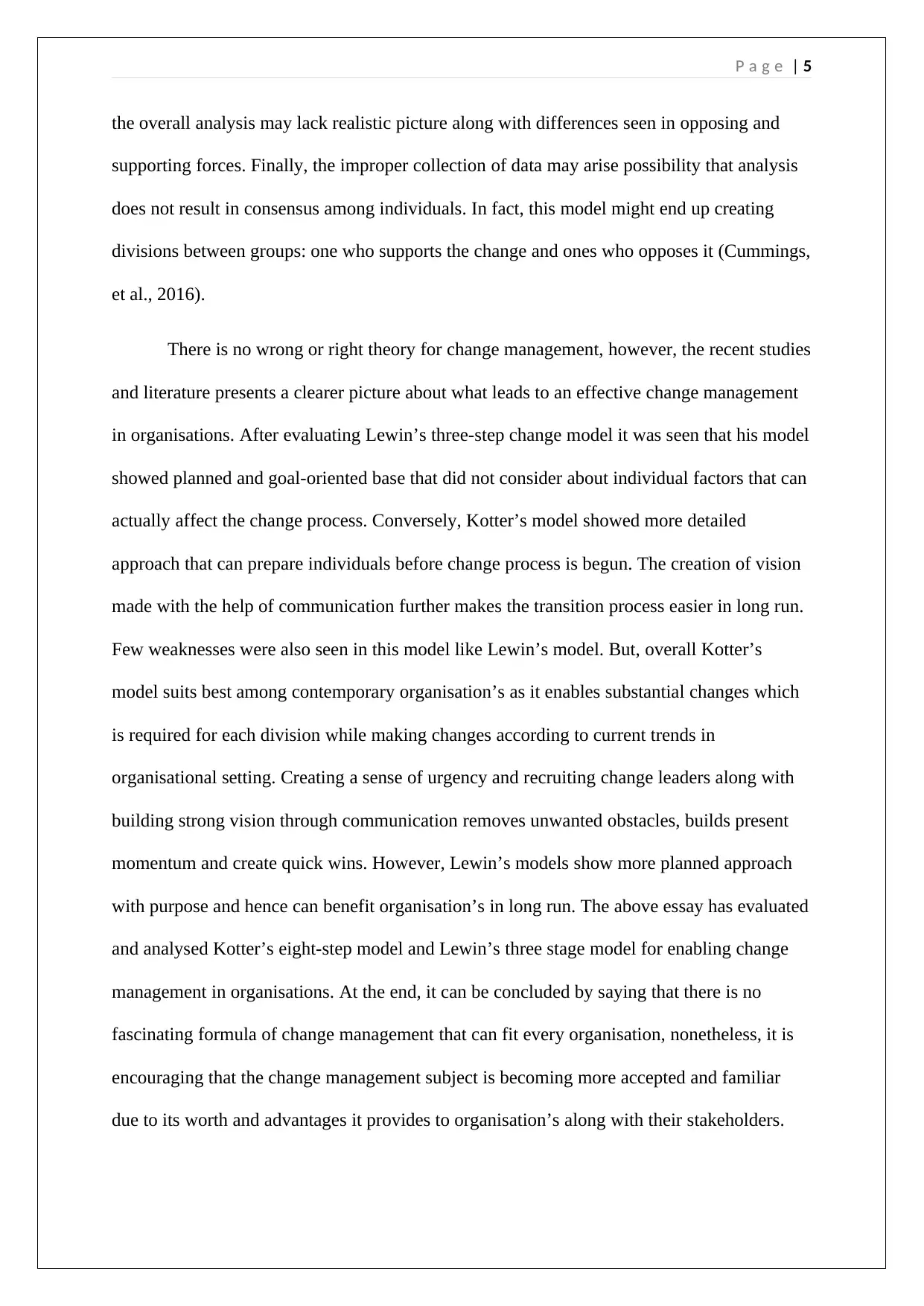
P a g e | 5
the overall analysis may lack realistic picture along with differences seen in opposing and
supporting forces. Finally, the improper collection of data may arise possibility that analysis
does not result in consensus among individuals. In fact, this model might end up creating
divisions between groups: one who supports the change and ones who opposes it (Cummings,
et al., 2016).
There is no wrong or right theory for change management, however, the recent studies
and literature presents a clearer picture about what leads to an effective change management
in organisations. After evaluating Lewin’s three-step change model it was seen that his model
showed planned and goal-oriented base that did not consider about individual factors that can
actually affect the change process. Conversely, Kotter’s model showed more detailed
approach that can prepare individuals before change process is begun. The creation of vision
made with the help of communication further makes the transition process easier in long run.
Few weaknesses were also seen in this model like Lewin’s model. But, overall Kotter’s
model suits best among contemporary organisation’s as it enables substantial changes which
is required for each division while making changes according to current trends in
organisational setting. Creating a sense of urgency and recruiting change leaders along with
building strong vision through communication removes unwanted obstacles, builds present
momentum and create quick wins. However, Lewin’s models show more planned approach
with purpose and hence can benefit organisation’s in long run. The above essay has evaluated
and analysed Kotter’s eight-step model and Lewin’s three stage model for enabling change
management in organisations. At the end, it can be concluded by saying that there is no
fascinating formula of change management that can fit every organisation, nonetheless, it is
encouraging that the change management subject is becoming more accepted and familiar
due to its worth and advantages it provides to organisation’s along with their stakeholders.
the overall analysis may lack realistic picture along with differences seen in opposing and
supporting forces. Finally, the improper collection of data may arise possibility that analysis
does not result in consensus among individuals. In fact, this model might end up creating
divisions between groups: one who supports the change and ones who opposes it (Cummings,
et al., 2016).
There is no wrong or right theory for change management, however, the recent studies
and literature presents a clearer picture about what leads to an effective change management
in organisations. After evaluating Lewin’s three-step change model it was seen that his model
showed planned and goal-oriented base that did not consider about individual factors that can
actually affect the change process. Conversely, Kotter’s model showed more detailed
approach that can prepare individuals before change process is begun. The creation of vision
made with the help of communication further makes the transition process easier in long run.
Few weaknesses were also seen in this model like Lewin’s model. But, overall Kotter’s
model suits best among contemporary organisation’s as it enables substantial changes which
is required for each division while making changes according to current trends in
organisational setting. Creating a sense of urgency and recruiting change leaders along with
building strong vision through communication removes unwanted obstacles, builds present
momentum and create quick wins. However, Lewin’s models show more planned approach
with purpose and hence can benefit organisation’s in long run. The above essay has evaluated
and analysed Kotter’s eight-step model and Lewin’s three stage model for enabling change
management in organisations. At the end, it can be concluded by saying that there is no
fascinating formula of change management that can fit every organisation, nonetheless, it is
encouraging that the change management subject is becoming more accepted and familiar
due to its worth and advantages it provides to organisation’s along with their stakeholders.
⊘ This is a preview!⊘
Do you want full access?
Subscribe today to unlock all pages.

Trusted by 1+ million students worldwide
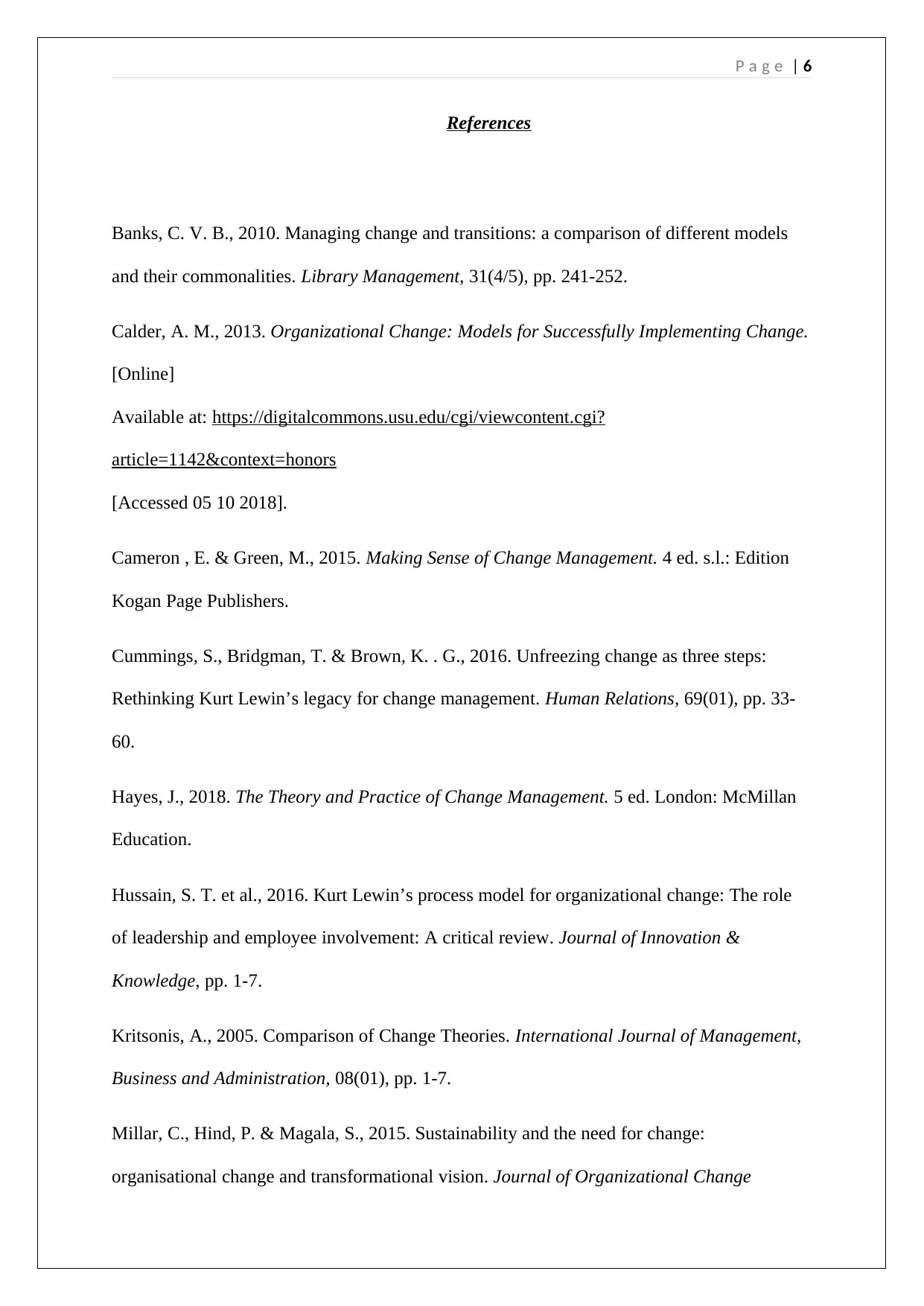
P a g e | 6
References
Banks, C. V. B., 2010. Managing change and transitions: a comparison of different models
and their commonalities. Library Management, 31(4/5), pp. 241-252.
Calder, A. M., 2013. Organizational Change: Models for Successfully Implementing Change.
[Online]
Available at: https://digitalcommons.usu.edu/cgi/viewcontent.cgi?
article=1142&context=honors
[Accessed 05 10 2018].
Cameron , E. & Green, M., 2015. Making Sense of Change Management. 4 ed. s.l.: Edition
Kogan Page Publishers.
Cummings, S., Bridgman, T. & Brown, K. . G., 2016. Unfreezing change as three steps:
Rethinking Kurt Lewin’s legacy for change management. Human Relations, 69(01), pp. 33-
60.
Hayes, J., 2018. The Theory and Practice of Change Management. 5 ed. London: McMillan
Education.
Hussain, S. T. et al., 2016. Kurt Lewin’s process model for organizational change: The role
of leadership and employee involvement: A critical review. Journal of Innovation &
Knowledge, pp. 1-7.
Kritsonis, A., 2005. Comparison of Change Theories. International Journal of Management,
Business and Administration, 08(01), pp. 1-7.
Millar, C., Hind, P. & Magala, S., 2015. Sustainability and the need for change:
organisational change and transformational vision. Journal of Organizational Change
References
Banks, C. V. B., 2010. Managing change and transitions: a comparison of different models
and their commonalities. Library Management, 31(4/5), pp. 241-252.
Calder, A. M., 2013. Organizational Change: Models for Successfully Implementing Change.
[Online]
Available at: https://digitalcommons.usu.edu/cgi/viewcontent.cgi?
article=1142&context=honors
[Accessed 05 10 2018].
Cameron , E. & Green, M., 2015. Making Sense of Change Management. 4 ed. s.l.: Edition
Kogan Page Publishers.
Cummings, S., Bridgman, T. & Brown, K. . G., 2016. Unfreezing change as three steps:
Rethinking Kurt Lewin’s legacy for change management. Human Relations, 69(01), pp. 33-
60.
Hayes, J., 2018. The Theory and Practice of Change Management. 5 ed. London: McMillan
Education.
Hussain, S. T. et al., 2016. Kurt Lewin’s process model for organizational change: The role
of leadership and employee involvement: A critical review. Journal of Innovation &
Knowledge, pp. 1-7.
Kritsonis, A., 2005. Comparison of Change Theories. International Journal of Management,
Business and Administration, 08(01), pp. 1-7.
Millar, C., Hind, P. & Magala, S., 2015. Sustainability and the need for change:
organisational change and transformational vision. Journal of Organizational Change
Paraphrase This Document
Need a fresh take? Get an instant paraphrase of this document with our AI Paraphraser
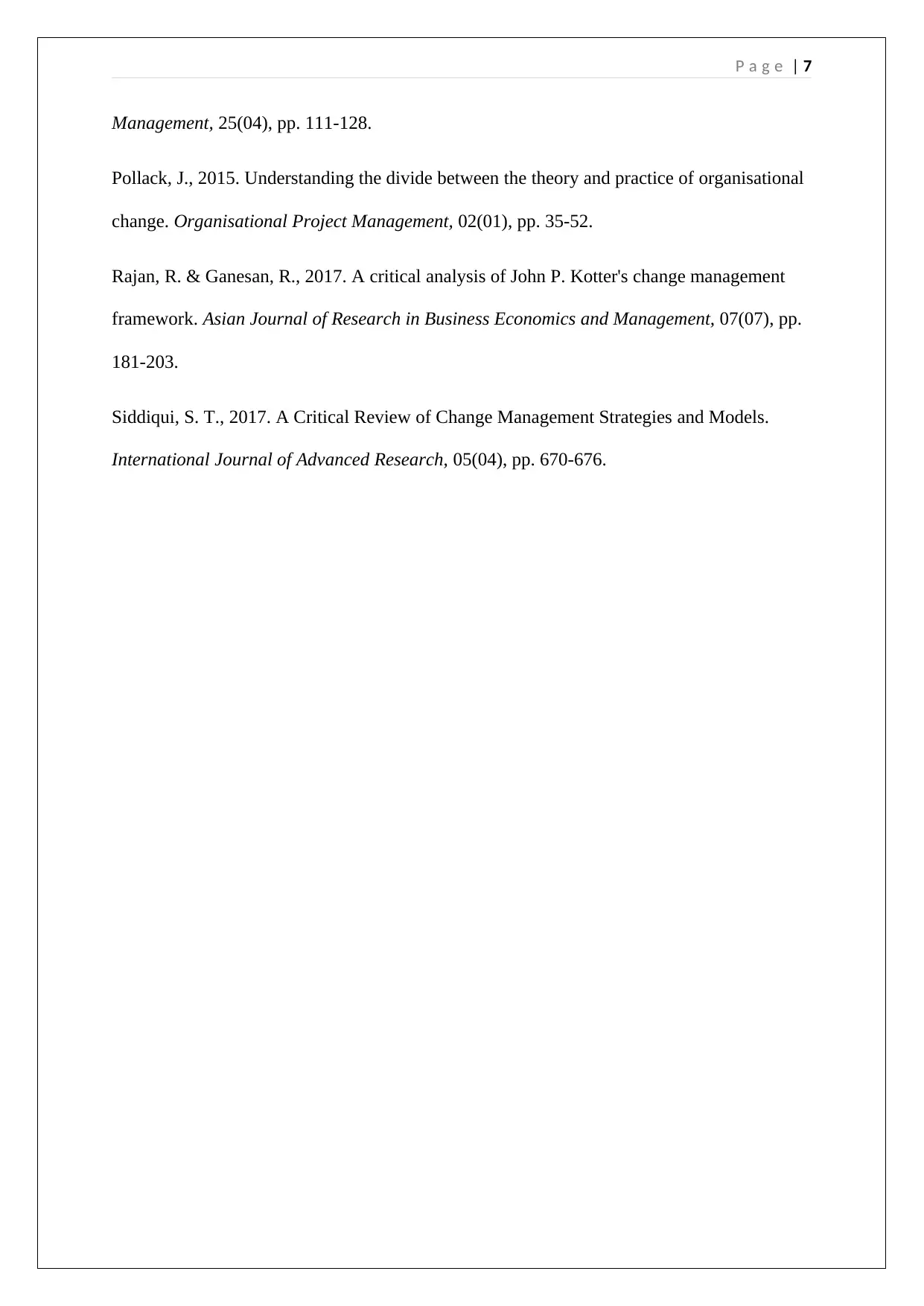
P a g e | 7
Management, 25(04), pp. 111-128.
Pollack, J., 2015. Understanding the divide between the theory and practice of organisational
change. Organisational Project Management, 02(01), pp. 35-52.
Rajan, R. & Ganesan, R., 2017. A critical analysis of John P. Kotter's change management
framework. Asian Journal of Research in Business Economics and Management, 07(07), pp.
181-203.
Siddiqui, S. T., 2017. A Critical Review of Change Management Strategies and Models.
International Journal of Advanced Research, 05(04), pp. 670-676.
Management, 25(04), pp. 111-128.
Pollack, J., 2015. Understanding the divide between the theory and practice of organisational
change. Organisational Project Management, 02(01), pp. 35-52.
Rajan, R. & Ganesan, R., 2017. A critical analysis of John P. Kotter's change management
framework. Asian Journal of Research in Business Economics and Management, 07(07), pp.
181-203.
Siddiqui, S. T., 2017. A Critical Review of Change Management Strategies and Models.
International Journal of Advanced Research, 05(04), pp. 670-676.
1 out of 8
Related Documents
Your All-in-One AI-Powered Toolkit for Academic Success.
+13062052269
info@desklib.com
Available 24*7 on WhatsApp / Email
![[object Object]](/_next/static/media/star-bottom.7253800d.svg)
Unlock your academic potential
Copyright © 2020–2025 A2Z Services. All Rights Reserved. Developed and managed by ZUCOL.





